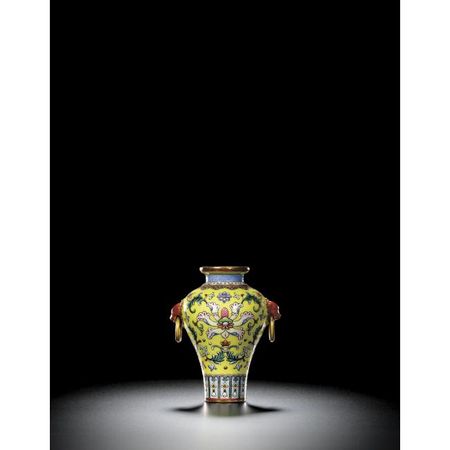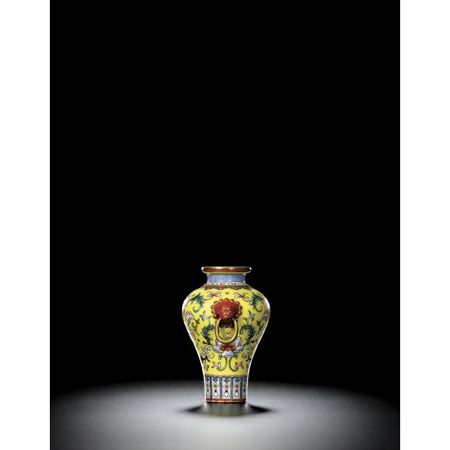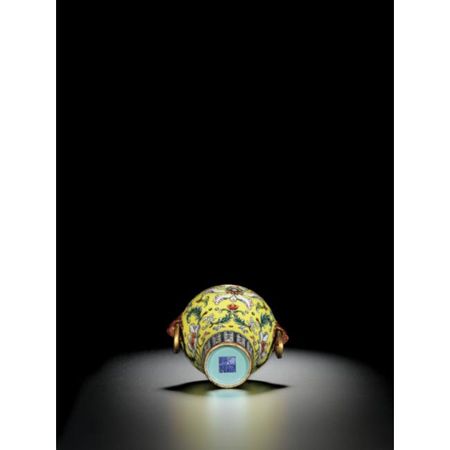An Exquisite Miniature 'Famille Rose' Yellow-Ground Sgraffiato Vase, Seal Mark and Period of Qianlong
An Exquisite Miniature 'Famille Rose' Yellow-Ground Sgraffiato Vase, Seal Mark and Period of Qianlong
of meiping form with broad sloping shoulders tapering sharply, meticulously painted in famille-rose enamels with a large stylised Indian lotus flower on each side encircled by feathery acanthus leaves borne from subordinate lotus blooms above and below, all reserved on a pale lemon yellow ground deftly incised through the enamelling with scrolls echoing the painted acanthus leaves, the shoulders set with a pair of raised iron-red and gilt lion masks, each clutching gilt painted loose-ring handles, all between a blue key-fret collar around the neck and sky blue upright lappets containing florets skirting the foot, the base marked with a six-character reign mark in underglaze blue reserved on a turquoise ground, the interior of the neck further enameled in turquoise and the mouth and footrim finished off with gilding. 11cm., 4 1/4 in. Estimate 3,000,000—5,000,000 HKD
PROVENANCE: Acquired in Europe in the 1960s.
LITERATURE AND REFERENCES: R.P. Marchant, 'Some Interesting Pieces of Marked Ch'ing Porcelain', Bulletin of the Oriental Ceramic Society of Hong Kong, no. 3, 1977-8, pls 17-19.
NOTE: While large, impressive objects can quickly catch the attention of the viewer; the beauty of miniature pieces lies in the extraordinary level of craftsmanship and amazing detail achieved by the artist who has applied his masterly skills onto a much smaller surface. The Qianlong emperor was an enthusiastic collector of all kinds of curios and miniature artefacts that were contained in specially crafted treasure boxes. The interior of the treasure boxes were divided into small compartments that safely held the objects. This vase would have been placed in a treasure box with other miniature objects made in various mediums and precious materials. Miniature artefacts had the advantage of being easy to hold and privately enjoy, as well as being easy to collect. They were stored in the private quarters of the Inner Palace in the Forbidden City where Qianlong and his family members were able to take pleasure in them at their leisure. For an example of a treasure box filled with miniature pieces see one illustrated in Masterpieces of Chinese Miniature Crafts in the National Palace Museum, Taipei, 1971, pl.7
Every aspect of this meiping is carefully planned and executed. The painting is delicately detailed while the use of the complicated and laborious sgraffiato technique for the central body, structured by needle-point etching of endless strolling fronds on a yellow-enamel ground, is possibly the finest example one can find on such a small surface. The ring-handles are loose and can be turned through the Buddhist lion masks. They are well made especially on the sgraffiato- ground where the spacing of the scroll work had to be carefully planned. The painting style is typical of the Qianlong period with the beauty of the lotus flower enhanced by gentle shading. The six-character Qianlong reign mark on the base is also carefully positioned exactly between the handles with the top of the mark parallel with the line between the handles.
The present meiping appears to be the only example of its kind. It possibly takes its inspiration from the famous and much larger ruby-ground meiping, similarly decorated in the sgraffiato method and painted with a large variety of stylized flowers including lotus with its petals shaded in the Western style, preserved in the Palace Museum, Beijing, illustrated in Kangxi. Yongzheng. Qianlong: Qing Porcelain from the Palace Museum Collection, Hong Kong, 1989, p. 361, pl. 42.
The sgraffiato technique was first included in the repertoire of the Jingdezhen potters during the Qianlong period and was used for decorating very special pieces, whether large or small. A number of sgraffiato-ground vessels enamelled in different colour schemes, from the Qing Court collection and now in the National Palace Museum, Taipei, are included in Stunning Decorative Porcelains from the Ch'ien-lung Reign, Taipei, 2008. For example, see a cup and tray set in yangcai enamels with incised lemon-yellow ground pattern of flower brocade and landscape decoration, ibid., pl. 7; and an openwork vase with incised decoration of flowers on a similar yellow-ground, ibid., pl. 73 (fig. 1)
For examples of exquisite miniature vessels see three mallet-form vases painted in famille-rose enamels with lotus scroll design published ibid., pls. 25-27; two other miniature bottles painted in the falangcai palette, one from the Qing Court collection and still in Beijing, decorated with rural scenes, illustrated in The Complete Collection of Treasures of the Palace Museum. Porcelains with Cloisonne Enamel Decoration and Famille Rose Decoration, Hong Kong, 1999, pl. 36, and the other with the 'mother and child' motif, from the J.M. Hu Family collection and included in the exhibition Min Chiu Society Thirtieth Anniversary Exhibition, Hong Kong Museum of Art, Hong Kong, 1990, cat. no. 167, sold in these rooms, 8th April 2007, lot 806.
Sotheby's. Eight Treasures from a European Collection. 08 Apr 09. Hong Kong. www.sothebys.com photo courtesy Sotheby's

/https%3A%2F%2Fprofilepics.canalblog.com%2Fprofilepics%2F1%2F0%2F100183.jpg)







/http%3A%2F%2Fstorage.canalblog.com%2F84%2F52%2F577050%2F66521567_o.jpg)
/http%3A%2F%2Fstorage.canalblog.com%2F38%2F35%2F577050%2F66167687_o.jpg)
/http%3A%2F%2Fstorage.canalblog.com%2F57%2F06%2F577050%2F65483531_o.jpg)
/http%3A%2F%2Fstorage.canalblog.com%2F36%2F45%2F119589%2F65107496_p.jpg)